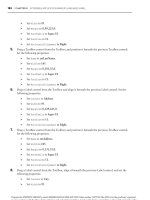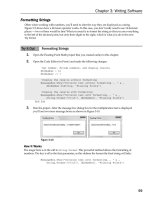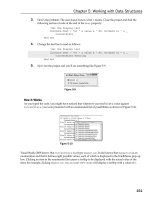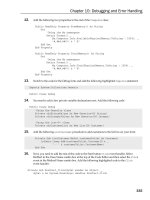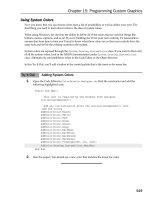Beginning Microsoft Visual C# 2008 PHẦN 1 potx
Bạn đang xem bản rút gọn của tài liệu. Xem và tải ngay bản đầy đủ của tài liệu tại đây (1.62 MB, 135 trang )
Beginning
Microsoft® Visual C#® 2008
Karli Watson
Christian Nagel
Jacob Hammer Pedersen
Jon D. Reid
Morgan Skinner
Eric White
Wiley Publishing, Inc.
ffirs.indd iiiffirs.indd iii 3/24/08 5:45:20 PM3/24/08 5:45:20 PM
ffirs.indd viiiffirs.indd viii 3/24/08 5:45:21 PM3/24/08 5:45:21 PM
Beginning
Microsoft® Visual C#® 2008
Introduction xxvii
Part I: The C# Language
Chapter 1: Introducing C# 3
Chapter 2: Writing a C# Program 13
Chapter 3: Variables and Expressions 31
Chapter 4: Flow Control 59
Chapter 5: More About Variables 93
Chapter 6: Functions 125
Chapter 7: Debugging and Error Handling 155
Chapter 8: Introduction to Object-Oriented Programming 185
Chapter 9: Defining Classes 209
Chapter 10: Defining Class Members 241
Chapter 11: Collections, Comparisons, and Conversions 277
Chapter 12: Generics 331
Chapter 13: Additional OOP Techniques 371
Chapter 14: C# 3.0 Language Enhancements 399
Part II: Windows Programming
Chapter 15: Basic Windows Programming 433
Chapter 16: Advanced Windows Forms Features 493
Chapter 17: Using Common Dialogs 537
Chapter 18: Deploying Windows Applications 583
Part III: Web Programming
Chapter 19: Basic Web Programming 627
Chapter 20: Advanced Web Programming 671
(Continued)
ffirs.indd iffirs.indd i 3/24/08 5:45:19 PM3/24/08 5:45:19 PM
Chapter 21: Web Services 709
Chapter 22: Ajax Programming 739
Chapter 23: Deploying Web Applications 759
Part IV: Data Access
Chapter 24: File System Data 777
Chapter 25: XML 819
Chapter 26: Introduction to LINQ 849
Chapter 27: LINQ to SQL 895
Chapter 28: ADO.NET and LINQ over DataSet 933
Chapter 29: LINQ to XML 993
Part V: Additional Techniques
Chapter 30: Attributes 1019
Chapter 31: XML Documentation 1049
Chapter 32: Networking 1075
Chapter 33: Introduction to GDI+ 1107
Chapter 34: Windows Presentation Foundation 1143
Chapter 35: Windows Communication Foundation 1215
Chapter 36: Windows Workflow Foundation 1247
Index 1279
ffirs.indd iiffirs.indd ii 3/24/08 5:45:20 PM3/24/08 5:45:20 PM
Beginning
Microsoft® Visual C#® 2008
Karli Watson
Christian Nagel
Jacob Hammer Pedersen
Jon D. Reid
Morgan Skinner
Eric White
Wiley Publishing, Inc.
ffirs.indd iiiffirs.indd iii 3/24/08 5:45:20 PM3/24/08 5:45:20 PM
Beginning Microsoft® Visual C#® 2008
Published by
Wiley Publishing, Inc.
10475 Crosspoint Boulevard
Indianapolis, IN 46256
www.wiley.com
Copyright © 2008 by Wiley Publishing, Inc., Indianapolis, Indiana
Published simultaneously in Canada
ISBN: 978-0-470-19135-4
Manufactured in the United States of America
10 9 8 7 6 5 4 3 2 1
Library of Congress Cataloging-in-Publication Data is available from the publisher.
No part of this publication may be reproduced, stored in a retrieval system or transmitted in any form or by
any means, electronic, mechanical, photocopying, recording, scanning or otherwise, except as permitted
under Sections 107 or 108 of the 1976 United States Copyright Act, without either the prior written
permission of the Publisher, or authorization through payment of the appropriate per-copy fee to the
Copyright Clearance Center, 222 Rosewood Drive, Danvers, MA 01923, (978) 750-8400, fax (978) 646-8600.
Requests to the Publisher for permission should be addressed to the Legal Department, Wiley Publishing,
Inc., 10475 Crosspoint Blvd., Indianapolis, IN 46256, (317) 572-3447, fax (317) 572-4355, or online at
/>Limit of Liability/Disclaimer of Warranty: The publisher and the author make no representations or
warranties with respect to the accuracy or completeness of the contents of this work and specifically
disclaim all warranties, including without limitation warranties of fitness for a particular purpose. No
warranty may be created or extended by sales or promotional materials. The advice and strategies contained
herein may not be suitable for every situation. This work is sold with the understanding that the publisher is
not engaged in rendering legal, accounting, or other professional services. If professional assistance is
required, the services of a competent professional person should be sought. Neither the publisher nor the
author shall be liable for damages arising herefrom. The fact that an organization or Website is referred to in
this work as a citation and/or a potential source of further information does not mean that the author or the
publisher endorses the information the organization or Website may provide or recommendations it may
make. Further, readers should be aware that Internet Websites listed in this work may have changed or
disappeared between when this work was written and when it is read.
For general information on our other products and services please contact our Customer Care Department
within the United States at (800) 762-2974, outside the United States at (317) 572-3993 or fax (317) 572-4002.
Trademarks: Wiley, the Wiley logo, Wrox, the Wrox logo, Wrox Programmer to Programmer, and related
trade dress are trademarks or registered trademarks of John Wiley & Sons, Inc. and/or its affiliates, in the
United States and other countries, and may not be used without written permission. Microsoft and Visual
C# are registered trademarks of Microsoft Corporation in the United States and/or other countries. All other
trademarks are the property of their respective owners. Wiley Publishing, Inc., is not associated with any
product or vendor mentioned in this book.
Wiley also publishes its books in a variety of electronic formats. Some content that appears in print may not
be available in electronic books.
ffirs.indd ivffirs.indd iv 3/24/08 5:45:20 PM3/24/08 5:45:20 PM
Thanks to everyone at Wiley for helping me through this project and reigning in my strange British stylings, to
assorted clients for giving me the time to write, and to Donna for keeping me sane and coping with my
temperamental back. Thanks also to friends and family for being patient with my deadline-laden lifestyle.
—Karli Watson
To my wife, Beth, and our children, Nathaniel, Timothy, and Walter. Thanks for your support and encouragement.
Also a big thank-you to my co-authors and the team at Wrox/Wiley.
—Jon Reid
To Mum and Dad: No words can express how much I love and miss you. Thanks for everything, you were brilliant.
—Morgan Skinner
ffirs.indd vffirs.indd v 3/24/08 5:45:20 PM3/24/08 5:45:20 PM
About the Authors
Karli Watson is a freelance IT specialist, author, and developer. He is also a technical consultant for
3form Ltd. (
www.3form.net) and Boost.net (www.boost.net), and an associate technologist with
Content Master (
www.contentmaster.com). For the most part, he immerses himself in .NET
(in particular, C#) and has written numerous books in the field. He specializes in communicating
complex ideas in a way that is accessible to anyone with a passion to learn, and spends much of his
time playing with new technology to find new things to teach people.
During those rare times when he isn’t doing the above, Karli is probably wishing he were hurtling down
a mountain on a snowboard or possibly trying to get his novel published. Either way, you’ll know him
by his brightly colored clothes.
Christian Nagel is a software architect, trainer, and consultant, and an associate of Thinktecture
(
www.thinktecture.com), offering training and coaching based on Microsoft .NET technologies. His
achievements in the developer community have earned him a position as Microsoft Regional Director
and MVP for ASP.NET. He enjoys an excellent reputation as an author of several .NET books, such as
Professional C#, Pro .NET Network Programming, and Enterprise Services with the .NET Frameworks, and he
speaks regularly at international industry conferences.
Christian has more than 15 years of experience as a developer and software architect. He started his
computing career on PDP 11 and VAX/VMS, covering a variety of languages and platforms. Since 2000,
he has been working with .NET and C#, developing and architecting distributed solutions. He can be
reached at
www.christiannagel.com.
Jacob Hammer Pedersen is a systems developer at Fujitsu Service, Denmark. He’s been programming the
PC since the early 1990s using various languages, including Pascal, Visual Basic, C/C++, and C#. Jacob
has co-authored a number of .NET books and works with a wide variety of Microsoft technologies,
ranging from SQL Server to Office extensibility. A Danish citizen, he works and lives in Aarhus, Denmark.
Jon D. Reid is the director of systems engineering at Indigo Biosystems, Inc. (
www.indigobio.com),
an independent software vendor for the life sciences, where he develops in C# for the Microsoft
environment. He has co-authored many .NET books, including Beginning Visual C# 2005, Beginning C#
Databases: From Novice to Professional, Pro Visual Studio .NET, ADO.NET Programmer’s Reference, and
Professional SQL Server 2000 XML.
Morgan Skinner started programming at school in 1980 and has been hooked on computing ever since.
He now works for Microsoft as an application development consultant where he helps customers with
their architecture, design, coding, and testing. He’s been working with .NET since the PDC release in
2000, and has authored several MSDN articles and co-authored a couple of books on .NET. In his spare
time he relaxes by fighting weeds on his allotment. You can reach Morgan at
www.morganskinner.com.
Eric White is an independent software consultant with more than 20 years of experience in building
management information systems and accounting systems. When he isn’t hunched over a screen
programming in C#, he is most likely to be found with an ice axe in hand, climbing some mountain.
ffirs.indd viffirs.indd vi 3/24/08 5:45:20 PM3/24/08 5:45:20 PM
Acquisitions Editor
Katie Mohr
Development Editor
Maryann Steinhart
Technical Editor
Douglas Parsons
Production Editor
William A. Barton
Copy Editor
Luann Rouff
Editorial Manager
Mary Beth Wakefield
Production Manager
Tim Tate
Vice President and Executive Group
Publisher
Richard Swadley
Vice President and Executive Publisher
Joseph B. Wikert
Project Coordinator, Cover
Lynsey Stanford
Proofreaders
Jeremy Bagai,
Josh Chase,
David Fine,
Reed Kellman,
Scott Klemp,
Josh Peterson,
Todd Spencer,
Word One
Indexer
Robert Swanson
Credits
ffirs.indd viiffirs.indd vii 3/24/08 5:45:21 PM3/24/08 5:45:21 PM
ffirs.indd viiiffirs.indd viii 3/24/08 5:45:21 PM3/24/08 5:45:21 PM
Contents
Introduction xxvii
Part I: The C# Language 1
Chapter 1: Introducing C# 3
What Is the .NET Framework? 3
What’s in the .NET Framework? 4
Writing Applications Using the .NET Framework 4
What Is C#? 8
Applications You Can Write with C# 8
C# in This Book 9
Visual Studio 2008 9
Visual Studio 2008 Express Products 10
Solutions 10
Summary 11
Chapter 2: Writing a C# Program 13
The Development Environments 14
Visual Studio 2008 14
Visual C# 2008 Express Edition 17
Console Applications 18
The Solution Explorer 22
The Properties Window 23
The Error List Window 23
Windows Forms Applications 24
Summary 29
Chapter 3: Variables and Expressions 31
Basic C# Syntax 32
Basic C# Console Application Structure 34
Variables 36
Simple Types 36
Variable Naming 41
ftoc.indd ixftoc.indd ix 3/24/08 5:46:02 PM3/24/08 5:46:02 PM
Contents
x
Literal Values 43
Variable Declaration and Assignment 45
Expressions 46
Mathematical Operators 46
Assignment Operators 51
Operator Precedence 52
Namespaces 53
Summary 56
Exercises 57
Chapter 4: Flow Control 59
Boolean Logic 59
Bitwise Operators 62
Boolean Assignment Operators 66
Operator Precedence Updated 68
The goto Statement 69
Branching 70
The Ternary Operator 70
The if Statement 71
The switch Statement 75
Looping 78
do Loops 79
while Loops 81
for Loops 83
Interrupting Loops 88
Infinite Loops 89
Summary 90
Exercises 90
Chapter 5: More About Variables 93
Type Conversion 93
Implicit Conversions 94
Explicit Conversions 96
Explicit Conversions Using the Convert Commands 100
Complex Variable Types 103
Enumerations 103
Structs 108
Arrays 111
String Manipulation 118
Summary 123
Exercises 124
ftoc.indd xftoc.indd x 3/24/08 5:46:03 PM3/24/08 5:46:03 PM
Contents
xi
Chapter 6: Functions 125
Defining and Using Functions 126
Return Values 128
Parameters 130
Variable Scope 138
Variable Scope in Other Structures 141
Parameters and Return Values versus Global Data 143
The Main() Function 144
Struct Functions 147
Overloading Functions 148
Delegates 150
Summary 153
Exercises 154
Chapter 7: Debugging and Error Handling 155
Debugging in VS and VCE 156
Debugging in Nonbreak (Normal) Mode 157
Debugging in Break Mode 166
Error Handling 176
try . . . catch . . . finally 177
Listing and Configuring Exceptions 182
Notes on Exception Handling 183
Summary 184
Exercises 184
Chapter 8: Introduction to Object-Oriented Programming 185
What Is Object-Oriented Programming? 186
What Is an Object? 187
Everything’s an Object 190
The Life Cycle of an Object 190
Static and Instance Class Members 191
OOP Techniques 192
Interfaces 193
Inheritance 195
Polymorphism 197
Relationships between Objects 199
Operator Overloading 201
Events 202
Reference versus Value Types 202
ftoc.indd xiftoc.indd xi 3/24/08 5:46:03 PM3/24/08 5:46:03 PM
Contents
xii
OOP in Windows Applications 203
Summary 206
Exercises 206
Chapter 9: Defining Classes 209
Class Definitions in C# 209
Interface Definitions 213
System.Object 216
Constructors and Destructors 218
Constructor Execution Sequence 219
OOP Tools in VS and VCE 223
The Class View Window 223
The Object Browser 225
Adding Classes 226
Class Diagrams 227
Class Library Projects 229
Interfaces Versus Abstract Classes 233
Struct Types 235
Shallow Copying versus Deep Copying 238
Summary 238
Exercises 239
Chapter 10: Defining Class Members 241
Member Definitions 241
Defining Fields 242
Defining Methods 242
Defining Properties 244
Adding Members from a Class Diagram 249
Refactoring Members 252
Automatic Properties 253
Additional Class Member Topics 254
Hiding Base Class Methods 254
Calling Overridden or Hidden Base Class Methods 256
Nested Type Definitions 257
Interface Implementation 257
Implementing Interfaces in Classes 259
Partial Class Definitions 262
Partial Method Definitions 264
ftoc.indd xiiftoc.indd xii 3/24/08 5:46:03 PM3/24/08 5:46:03 PM
Contents
xiii
Example Application 265
Planning the Application 266
Writing the Class Library 267
A Client Application for the Class Library 274
Summary 276
Exercises 276
Chapter 11: Collections, Comparisons, and Conversions 277
Collections 277
Using Collections 278
Defining Collections 285
Indexers 286
Adding a Cards Collection to CardLib 289
Keyed Collections and IDictionary 292
Iterators 294
Deep Copying 299
Adding Deep Copying to CardLib 302
Comparisons 303
Type Comparison 304
Value Comparison 309
Conversions 326
Overloading Conversion Operators 326
The as Operator 327
Summary 328
Exercises 329
Chapter 12: Generics 331
What Is a Generic? 331
Using Generics 333
Nullable Types 333
The System.Collections.Generics Namespace 341
Defining Generics 351
Defining Generic Classes 352
Defining Generic Interfaces 365
Defining Generic Methods 365
Defining Generic Delegates 367
Summary 368
Exercises 368
ftoc.indd xiiiftoc.indd xiii 3/24/08 5:46:04 PM3/24/08 5:46:04 PM
Contents
xiv
Chapter 13: Additional OOP Techniques 371
The :: Operator and the Global Namespace Qualifier 371
Custom Exceptions 373
Exception Base Classes 373
Adding Custom Exceptions to CardLib 374
Events 375
What Is an Event? 375
Handling Events 377
Defining Events 379
Expanding and Using CardLib 389
A Card Game Client for CardLib 389
Summary 397
Exercises 398
Chapter 14: C# 3.0 Language Enhancements 399
Initializers 400
Object Initializers 400
Collection Initializers 402
Type Inference 406
Anonymous Types 408
Extension Methods 412
Lambda Expressions 418
Anonymous Methods Recap 418
Lambda Expressions for Anonymous Methods 419
Lambda Expression Parameters 423
Lambda Expression Statement Bodies 424
Lambda Expressions as Delegates and Expression Trees 425
Lambda Expressions and Collections 426
Summary 429
Exercises 430
Part II: Windows Programming 431
Chapter 15: Basic Windows Programming 433
Controls 434
Properties 434
Anchoring, Docking, and Snapping Controls 435
Events 437
ftoc.indd xivftoc.indd xiv 3/24/08 5:46:04 PM3/24/08 5:46:04 PM
Contents
xv
The Button Control 440
Button Properties 440
Button Events 441
The Label and LinkLabel Controls 443
The TextBox Control 444
TextBox Properties 445
TextBox Events 446
The RadioButton and CheckBox Controls 454
RadioButton Properties 455
RadioButton Events 455
CheckBox Properties 456
CheckBox Events 456
The GroupBox Control 457
The RichTextBox Control 461
RichTextBox Properties 462
RichTextBox Events 463
The ListBox and CheckedListBox Controls 469
ListBox Properties 470
ListBox Methods 471
ListBox Events 472
The ListView Control 475
ListView Properties 475
ListView Methods 477
ListView Events 478
ListViewItem 478
ColumnHeader 478
The ImageList Control 478
The TabControl Control 486
TabControl Properties 487
Working with the TabControl 488
Summary 491
Exercises 492
Chapter 16: Advanced Windows Forms Features 493
Menus and Toolbars 494
Two Is One 494
Using the MenuStrip Control 494
Creating Menus Manually 495
Additional Properties of the ToolStripMenuItem 498
Adding Functionality to Menus 499
ftoc.indd xvftoc.indd xv 3/24/08 5:46:04 PM3/24/08 5:46:04 PM
Contents
xvi
Toolbars 501
ToolStrip Properties 502
ToolStrip Items 503
StatusStrip 509
StatusStripStatusLabel Properties 509
SDI and MDI Applications 512
Building MDI Applications 514
Creating Controls 524
A LabelTextbox Control 526
Debugging User Controls 530
Extending the LabelTextbox Control 531
Summary 535
Exercises 535
Chapter 17: Using Common Dialogs 537
Common Dialogs 537
How to Use Dialogs 539
File Dialogs 540
OpenFileDialog 540
SaveFileDialog 553
Printing 559
Printing Architecture 560
Printing Multiple Pages 565
PageSetupDialog 568
PrintDialog 570
Print Preview 575
PrintPreviewDialog 575
PrintPreviewControl 576
FontDialog and ColorDialog 577
FontDialog 577
ColorDialog 579
FolderBrowserDialog 580
Summary 581
Exercises 582
Chapter 18: Deploying Windows Applications 583
Deployment Overview 583
ClickOnce Deployment 584
Updates 595
Visual Studio Setup and Deployment Project Types 597
ftoc.indd xviftoc.indd xvi 3/24/08 5:46:05 PM3/24/08 5:46:05 PM
Contents
xvii
Microsoft Windows Installer Architecture 598
Windows Installer Terms 599
Advantages of the Windows Installer 601
Creating an Installation Package for the SimpleEditor 602
Planning the Installation 602
Creating the Project 603
Project Properties 604
File System Editor 607
File Types Editor 611
Launch Condition Editor 612
User Interface Editor 613
Building the Project 617
Installation 617
Welcome 618
Read Me 618
License Agreement 619
Optional Files 619
Select Installation Folder 620
Confirm Installation 621
Progress 621
Installation Complete 622
Running the Application 622
Uninstall 622
Summary 622
Exercises 623
Part III: Web Programming 625
Chapter 19: Basic Web Programming 627
Overview 628
ASP.NET Runtime 628
Creating a Simple Page 629
Server Controls 636
Event Handlers 637
Input Validation 642
State Management 646
Client-Side State Management 646
Server-Side State Management 648
Authentication and Authorization 652
Authentication Configuration 652
Using Security Controls 657
ftoc.indd xviiftoc.indd xvii 3/24/08 5:46:05 PM3/24/08 5:46:05 PM
Contents
xviii
Reading and Writing to a SQL Server Database 660
Summary 669
Exercises 670
Chapter 20: Advanced Web Programming 671
Master Pages 671
Site Navigation 679
User Controls 680
Profiles 683
Profile Groups 685
Profiles with Components 686
Profiles with Custom Data Types 686
Profiles with Anonymous Users 687
Web Parts 688
Web Parts Manager 689
Web Parts Zone 689
Editor Zone 692
Catalog Zone 695
Connections 697
JavaScript 701
Script Element 701
Declaration of Variables 702
Defining Functions 702
Statements 702
Objects 703
Summary 707
Exercises 708
Chapter 21: Web Services 709
Before Web Services 710
Remote Procedure Call (RPC) 710
SOAP 711
Where to Use Web Services 711
A Hotel Travel Agency Application Scenario 712
A Book Distributor Application Scenario 712
Client Application Types 713
Application Architecture 713
Web Services Architecture 714
What Methods Can I Call? 714
Calling a Method 715
ftoc.indd xviiiftoc.indd xviii 3/24/08 5:46:05 PM3/24/08 5:46:05 PM
Contents
xix
SOAP and Firewalls 716
WS-I Basic Profile 717
Web Services and the .NET Framework 717
Creating a Web Service 717
Client 719
Creating a Simple ASP.NET Web Service 720
Adding a Web Method 721
Testing the Web Service 722
Implementing a Windows Client 724
Calling the Service Asynchronously 728
Implementing an ASP.NET Client 731
Passing Data 732
Summary 736
Exercises 737
Chapter 22: Ajax Programming 739
Ajax Overview 739
Update Panel 741
Timer Control 746
Update Progress 747
Web Services 749
Extender Controls 755
Summary 757
Exercises 757
Chapter 23: Deploying Web Applications 759
Internet Information Services 759
IIS Configuration 760
Copying a Web Site 763
Publishing a Web Site 765
Windows Installer 767
Creating a Setup Program 767
Installing the Web Application 769
Summary 772
Exercises 773
ftoc.indd xixftoc.indd xix 3/24/08 5:46:06 PM3/24/08 5:46:06 PM
Contents
xx
Part IV: Data Access 775
Chapter 24: File System Data 777
Streams 778
The Classes for Input and Output 778
The File and Directory Classes 780
The FileInfo Class 781
The DirectoryInfo Class 783
Path Names and Relative Paths 784
The FileStream Object 784
The StreamWriter Object 791
The StreamReader Object 794
Reading and Writing Compressed Files 802
Serialized Objects 805
Monitoring the File Structure 810
Summary 818
Exercises 818
Chapter 25: XML 819
XML Documents 819
XML Elements 820
Attributes 821
The XML Declaration 821
Structure of an XML Document 822
XML Namespaces 823
Well-Formed and Valid XML 824
Validating XML Documents 824
Using XML in Your Application 828
XML Document Object Model 828
Selecting Nodes 839
Summary 847
Exercises 848
Chapter 26: Introduction to LINQ 849
LINQ Varieties 850
First LINQ Query 850
Declaring a Variable for Results Using the var Keyword 852
Specify Data Source: from Clause 853
Specify Condition: where Clause 853
ftoc.indd xxftoc.indd xx 3/24/08 5:46:06 PM3/24/08 5:46:06 PM
Contents
xxi
Select Items: select Clause 854
Finishing Up: Using the foreach Loop 854
Deferred Query Execution 854
Using the LINQ Method Syntax and Lambda Expressions 855
LINQ Extension Methods 855
Query Syntax versus Method Syntax 855
Lambda Expressions 856
Ordering Query Results 858
orderby Clause 860
Ordering Using Method Syntax 860
Querying a Large Data Set 862
Aggregate Operators 865
Querying Complex Objects 868
Projection: Creating New Objects in Queries 872
Projection: Method Syntax 875
Select Distinct Query 875
Any and All 877
Ordering By Multiple Levels 879
Multi-Level Ordering Method Syntax: ThenBy 881
Group Queries 881
Take and Skip 883
First and FirstOrDefault 886
Set Operators 887
Joins 891
Resources and Further Reading 892
Summary 893
Exercises 893
Chapter 27: LINQ to SQL 895
Object-Relational Mapping (ORM) 896
Installing SQL Server and the Northwind Sample Data 896
Install SQL Server Express 2005 897
Installing the Northwind Sample Database 898
First LINQ to SQL Query 898
Navigating LINQ to SQL Relationships 907
Drilling Down Further with LINQ to SQL 911
Grouping, Ordering, and Other Advanced Queries in LINQ to SQL 914
Displaying Generated SQL 917
Data Binding with LINQ to SQL 921
Updating Bound Data with LINQ to SQL 928
Summary 929
Exercises 930
ftoc.indd xxiftoc.indd xxi 3/24/08 5:46:07 PM3/24/08 5:46:07 PM
Contents
xxii
Chapter 28: ADO.NET and LINQ over DataSet 933
What Is ADO.NET? 934
Why Is It Called ADO.NET? 934
Design Goals of ADO.NET 935
Overview of ADO.NET Classes and Objects 937
Provider Objects 937
Consumer Objects 938
Using the System.Data Namespace 939
Reading Data with the DataReader 940
Reading Data with the DataSet 948
Filling the DataSet with Data 948
Accessing Tables, Rows, and Columns in the DataSet 948
Updating the Database 952
Adding Rows to the Database 956
Deleting Rows 963
Accessing Multiple Tables in a DataSet 965
Relationships in ADO.NET 965
Navigating with Relationships 966
XML and ADO.NET 973
XML Support in ADO.NET DataSets 973
SQL Support in ADO.NET 977
SQL Commands in Data Adapters 977
Direct Execution of SQL Commands 980
Calling a SQL Stored Procedure 983
Using LINQ over DataSet with ADO.NET 985
When to Use LINQ over DataSet 985
Summary 990
Exercises 990
Chapter 29: LINQ to XML 993
LINQ to XML Functional Constructors 994
Saving and Loading an XML Document 998
Loading XML from a String 1001
Contents of a Saved XML Document 1001
Working with XML Fragments 1002
Generating XML from LINQ to SQL 1004
Displaying the Northwind Customer Orders XML Document 1008
How to Query an XML Document 1009
Using Query Members 1010
ftoc.indd xxiiftoc.indd xxii 3/24/08 5:46:07 PM3/24/08 5:46:07 PM



